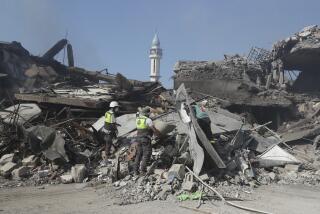Refugee Serbs Blame NATO in Camp Bombing
- Share via
MAJINO NASELJE, Yugoslavia — Half a mile up the road from where NATO pilots mistakenly bombed Kosovo Albanian refugees last week, warplanes on Wednesday pounded a Serbian refugee camp.
Four Serbs, including a young boy, died during a heavy airstrike, as most of the refugees were asleep around 3 a.m., survivors said in interviews at the scene. The attack damaged at least two apartment buildings housing refugees and left more than a dozen bomb craters.
The aircraft involved were not immediately identified, although Serbian refugees and Yugoslav government authorities blamed the attack on the North Atlantic Treaty Organization. But Army Col. Mike Phillips, a spokesman at NATO’s military headquarters in Mons, Belgium, said the alliance could not have been responsible because its aircraft were not operating in the area.
Serbian refugees at the camp were among the more than 200,000 ethnic Serbs driven from Croatia’s Krajina region in 1995 by Croatian troops. Many of those Serbian victims of “ethnic cleansing” still live in Yugoslavia.
Residents said the site should have been familiar to the West: U.S. diplomat William Walker, former head of a civilian team that monitored Kosovo’s cease-fire before NATO launched airstrikes March 24, had toured the camp three times, noted Novica Gulic, a survivor of Wednesday’s attack.
A week earlier, warplanes bombed ethnic Albanian refugees nearby in convoys headed toward the Albanian border. Five days later, NATO acknowledged its pilots had mistakenly attacked while trying to hit military vehicles.
As many as 80 Kosovo Albanians died at the site of last week’s airstrikes. NATO acknowledged that it might have killed some of them, but suggested that Yugoslav ground or air forces also might have attacked and killed the refugees.
A foreign reporter who visited the scene of Wednesday’s attack without a Yugoslav military or police escort counted more than a dozen craters in and around the refugees’ buildings.
The biggest explosion gouged a tear-drop shaped trench about 12 yards long, 10 yards across and 5 yards deep. Two other craters were each about 12 yards by 9 yards and about 5 yards deep.
Four smaller craters and at least half a dozen large ones were in a field next to the compound. One bomb destroyed a truck, but it was impossible to tell from the wreckage whether it was a military vehicle.
About four miles northwest, in the Djakovica hospital, doctors were treating 19 Serbian survivors, ages 4 to 90, for various wounds that were not life threatening, said Dr. Burin Sahacija, an ethnic Albanian surgeon.
Another boy, in critical condition, was flown about 40 miles northeast to Pristina, Kosovo’s capital, where doctors were trying to save his life Wednesday afternoon, police said.
One of the victims hospitalized in Djakovica was a young girl named Milena Ivancevic, who hid her face behind a gray blanket as medical staff told visitors about her brother, Ivan. The body of the boy, about 6 years old, lay in a small locked chamber behind the hospital that serves as a morgue, waiting for someone to arrange his burial.
Three more bodies still lay in the ruins of the refugee camp early Wednesday afternoon. Two men died in one apartment. Police identified them as brothers, Vularevic and Radoje Davor.
A woman’s body was face down in the ruins of the neighboring apartment. None of the few survivors at the camp knew her name.
Between 200 and 300 Serbian refugees from the Krajina region lived in the camp, which had once been an agricultural cooperative, survivors said.
About 60 of them were in small apartments in the single-story building that suffered the heaviest hit in Wednesday’s attack. The bomb blasts destroyed at least four apartments and half a dozen cars.
Most of the victims had been in buildings that housed refugees. From the air, they might look like barracks, but on the ground, the remains had all the signs of civilian life.
There were potted plants, children’s shoes, rubber boots and women’s clothing.
Among the belongings loaded into a wheelbarrow was a sack of donated flour with “U.S.A.” printed across the front. It came from USAID, the U.S. government aid agency, and was certified “all purpose, enriched, blended and fortified with calcium and vitamin A.”
Serbian villagers complained that they had recently opened their doors to ethnic Albanian refugees.
“We were helping them,” said Grca Mara, 60, a Serbian refugee who was expelled from Benkovac, Croatia, in August 1995. “We were giving them food. We were taking care of their small kids and giving them clothing, and now you see what NATO does to us.”
Before the conflict in Kosovo--a province of Yugoslavia’s dominant republic, Serbia--the expulsion of Krajina’s Croatian Serbs was one of the larger exoduses of refugees in the bloody breakup of Yugoslavia. That disintegration started in Slovenia in 1992, moved to Croatia, and then Bosnia-Herzegovina, whose war ended with peace accords in December 1995.
Now Serbia and its smaller sister republic, Montenegro, are all that’s left of Yugoslavia, and Serbian refugees such as Gulic say they have nowhere left to flee.
In 1995, Croatian forces rounded up all the Serbs in Shibanik, her hometown on Croatia’s Adriatic coast. They were forced into Topusko, just south of the Croatian capital, Zagreb.
Then the Croats deported the Serbs in a massive column of tractors and cars, she said.
“Throughout Croatia, when we were driving, they were beating us and throwing stones at us--and everything else they possibly could,” she said.
*
Times staff writer Joel Havemann in Brussels contributed to this report.
All of Paul Watson’s dispatches from Kosovo are available on The Times’ Web site at https://www.latimes.com/dispatch.
More to Read
Sign up for Essential California
The most important California stories and recommendations in your inbox every morning.
You may occasionally receive promotional content from the Los Angeles Times.













